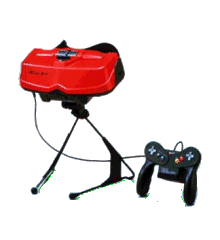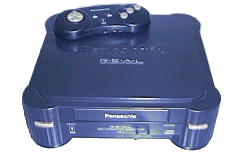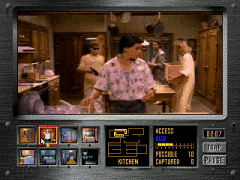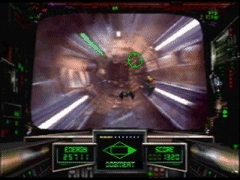Videogaming has had its share of ideas that worked and ideas that didn't, some of which continue to be a part of the growth of the history and hobby, and some of which are nothing more than footnotes. Who knew that Nolan Bushnell's first attempt of developing the first arcade videogame machine, Computer Space, which failed when it came out in 1970, would later resurface several years later in CinemaTronics' sleeper arcade classic Space War? Or that Atari's Surround and Midway's Checkmate games would be the inspiration for the lightcycle sequences in the Tron movie and arcade game? Or that people would still be making games based on characters from the videogame era of the early 1980s, and that people would be playing them?
However, there would be some ideas that gamers could only wish in some small way would make a comeback. These were ideas that were simply years ahead of their time, but their potential was hindered by technology that was not advanced enough to present a feasible (commercially or otherwise) product. Here are some examples of ideas that I think producers of gameware should consider bringing back to life in a new way:
Nintendo's Virtual Boy: Of all the systems Nintendo had released since the NES in 1985, this is perhaps the most striking example of how a company with a great track record of systems that could sell (including the Super NES, the Nintendo 64, the Gamecube, and the various incarnations of the Gameboy) had only one that didn't sell well enough to merit continuation. Released in 1995, the Virtual Boy was Nintendo's first attempt to develop a serious portable 3D gaming system that would allow for an immersive gaming experience; it was also in a way an attempt to replace the aging Gameboy system.
 Much like the Vectrex of a previous gaming generation, the Virtual Boy was a self-contained tabletop system featuring its own set of controllers hooked up to a pair of goggles into which a player would look to see what would be two juxtaposed monochrome (red-and-black graphics) images stereoscoped in such a way as to present the illusion of 3D graphics. As novel as this game system idea was, the problem was in the use of monochrome graphics, particularly the various shades of red images against a black background, which tended to hurt people's eyes after a while. The games that were released for this system also didn't help consumers be convinced of the "virtual" aspect enough to buy it. Sure, there were titles like Galactic Pinball, Tele Roboxer, VB Tetris, and Vertical Force, which showed the system's 3D imaging capabilities at work, but with gamers desiring the likes of Doom and Quake, which would be very difficult if not impossible to reproduce with any quality detail for the Virtual Boy, even what Nintendo offered as "3D games" for that system fell flat. The Virtual Boy had ceased being supported in 1997.
Much like the Vectrex of a previous gaming generation, the Virtual Boy was a self-contained tabletop system featuring its own set of controllers hooked up to a pair of goggles into which a player would look to see what would be two juxtaposed monochrome (red-and-black graphics) images stereoscoped in such a way as to present the illusion of 3D graphics. As novel as this game system idea was, the problem was in the use of monochrome graphics, particularly the various shades of red images against a black background, which tended to hurt people's eyes after a while. The games that were released for this system also didn't help consumers be convinced of the "virtual" aspect enough to buy it. Sure, there were titles like Galactic Pinball, Tele Roboxer, VB Tetris, and Vertical Force, which showed the system's 3D imaging capabilities at work, but with gamers desiring the likes of Doom and Quake, which would be very difficult if not impossible to reproduce with any quality detail for the Virtual Boy, even what Nintendo offered as "3D games" for that system fell flat. The Virtual Boy had ceased being supported in 1997.
Personally, I think the Virtual Boy idea can resurface in a new way...as a portable "immersive" version of the Nintendo 64 system. By replacing the imaging monitors with two ordinary backlit LCD screens arranged stereoscopically, in addition to replacing the guts of the Virtual Boy machine with Nintendo 64 techonology and the controllers for the system with Nintendo 64 controllers, this updated edition of the Virtual Boy could sell far better than its predecessor. With the decreasing cost of better LCD screen technology, this could really help the manufactuers out.
Digital Picture games: Tom Zito, the man who once worked for Hasbro to develop the game system simply known as Project N.E.M.O. as far as gaming history knows, took the same gaming ideas and technology he developed for that system to form a new company known as Digital Pictures in the early 1990s when Sega announced the upcoming release of the Sega CD for the Genesis system. Already he had two games ready by the time Sega CD made its debut in America -- Night Trap and Sewer Shark. The first game featured the late Dana Plato of Diff'rent Strokes starring as the undercover agent sent to protect some teenagers who have been invited to a slumber party, and your job is to help protect her and them by activating traps to fend off some intruders of the house. The second game was a first-person shoot-em-up where you're flying down sewer system tunnels that look like something straight out of Return Of The Jedi, shooting down rats and energy-sucking parasites and mechanical flying things all waiting for you in the tunnel, making sure also that you follow the directions of your robot guide or else you'll fly yourself into a dead end.
From that point on, Digital Pictures became involved in releasing several more games for the Sega CD, including translations for the 3DO, Sega Saturn, Macs and PCs. One of my favorites from Digital Pictures is Ground Zero, Texas, where you're blasting down citizens who have been engulfed by inhabiting alien beings in a sleepy Mexican-U.S. border town through "battle-cams". Though parts of this game, acting and scene-wise, were humorous and a bit hokey, I think this was a very good and serious effort of a game that played itself out like a movie. Another favorite of mine is Double Switch, a shorter yet tougher version of Night Trap featuring Corey Haim from The Lost Boys and Licensed To Drive as a computer hacker who's given you control of his advanced security system to protect the tenants of an apartment building from infiltrators and cult members. (Also in this game is Deborah Harry from the rock group Blondie, R. Lee Emrey from Full Metal Jacket, and Taylor Negron, the "pizza guy" from Fast Times At Ridgemont High.) However, Digital Pictures also released the rather questionable Make My Video series of games that attempted to make editing of music videos from Marky Mark, INXS, Kriss Kross, and C&C Music Factory into a videogaming experience.
If it weren't for the fact that Digital Pictures has done the "full motion video" gaming idea to death, which was part of the cause for the Sega CD's demise, I believe that the video compression technology of the systems of that time was the cause for killing Digital Pictures games. The overall result (at least from the games I have played on the Sega CD from that company) was grainy pictures with bleached-out colors and a sound quality that was more akin to a high-quality record player than the naturalistic sound of a compact disk. Another problem was that the video compression technology ate up valuable space on a CD-ROM, so games like Night Trap and Ground Zero, Texas wound up having to be stored on two disks instead of one. The worst offender of the bunch is Slam City with Scotty Pippen, a one-on-one basketball simulator that used up to four disks to store the game. Digital Pictures went out of business by around 1996 with the release of their last game, Quarterback Attack, their only known release for the Sony Playstation.
With DVD-ROM technology being a part of game consoles of this day and age, one can wonder if games like Night Trap and Sewer Shark might have a better chance of being re-released and utilizing the technology to fully bring the very idea Tom Zito had in mind with the conception of Project N.E.M.O. to fruition. Personally, I think it can be done; the compression technology alone can help cut down the number of disks a player has to mess around with. The only thing we have to watch out for is repeating the same mistakes Digital Pictures did in the output of their gameware. Other possible candidates for re-release along the same lines would be ICOM Simulations' Sherlock Holmes: Consulting Detective and their TurboGrafx-16 adaptation of the CinemaWare game, It Came From The Desert, a humorous take on the 1950s-style B-grade science fiction movies.
 The 3DO, CD-i, and CDTV: What really messed up these systems that had potential in the gaming marketplace wasn't just the technology; it was the lousy marketing behind them. Panasonic, Philips, and Commodore, the respective manufacturers of those systems, in an attempt to make these consoles accessible to more than just gamers, tried redefining them as "multimedia entertainment systems" or whatever choice buzzwords they actually used, to give the impression to consumers that they could do more than just simply play games, and that it was an ideal system for the whole family to use, short of the overall expense of buying a new computer. They came with very big price tags when they first came out ($700 for the Panasonic model of the 3DO system; I don't know what the CD-i and CDTV initially cost), and along with them, a handful of software with very few games listed among them. To contrast this, SNK's Neo-Geo system could be had for the same price in that period of time, and its cartridges were around $100 per title, but at the very least they sold the system the way they had meant it to be sold -- as a bona-fide gaming system, and nothing more. The idea that educational and personal improvement software could sell a "multimedia" system for the whole family may have all the good intentions in the world, and it looked better on paper, but all it really did for these units was cause identity confusion and drove consumers to purchase game systems that could play games and actually had games to play.
The 3DO, CD-i, and CDTV: What really messed up these systems that had potential in the gaming marketplace wasn't just the technology; it was the lousy marketing behind them. Panasonic, Philips, and Commodore, the respective manufacturers of those systems, in an attempt to make these consoles accessible to more than just gamers, tried redefining them as "multimedia entertainment systems" or whatever choice buzzwords they actually used, to give the impression to consumers that they could do more than just simply play games, and that it was an ideal system for the whole family to use, short of the overall expense of buying a new computer. They came with very big price tags when they first came out ($700 for the Panasonic model of the 3DO system; I don't know what the CD-i and CDTV initially cost), and along with them, a handful of software with very few games listed among them. To contrast this, SNK's Neo-Geo system could be had for the same price in that period of time, and its cartridges were around $100 per title, but at the very least they sold the system the way they had meant it to be sold -- as a bona-fide gaming system, and nothing more. The idea that educational and personal improvement software could sell a "multimedia" system for the whole family may have all the good intentions in the world, and it looked better on paper, but all it really did for these units was cause identity confusion and drove consumers to purchase game systems that could play games and actually had games to play. Philips also allowed for the CD-i to be able to play movies that were encoded specifically for that format in the hopes that potential purchasers would make that system a new standard for entertainment. It just simply didn't happen that way. The 3DO fared better out of the three systems listed, when actual games started being released for it, but even that went the way of its brethren after a few years of no real success.
Philips also allowed for the CD-i to be able to play movies that were encoded specifically for that format in the hopes that potential purchasers would make that system a new standard for entertainment. It just simply didn't happen that way. The 3DO fared better out of the three systems listed, when actual games started being released for it, but even that went the way of its brethren after a few years of no real success.
Fortunately, we don't have to make a wish list as far as revitalizing the idea behind these systems, for Sony and Microsoft with the respective releases of the Playstation 2 and the X-Box incorporated the DVD player technology and capability into them to allow for more than just games to be played on them, and they did it without trying to redefine these systems at all -- they just simply stayed gaming systems that had the additional feature of playing DVDs on them, and were marketed as such. (However, the X-Box does require you to buy a remote control for it in order to activate the DVD player feature, while the Playstation's is already activated straight out of the box.) More than that, Sony and Microsoft are intending to include the modem-type capability of playing games against another player directly online -- a feature that Catapult's XBand modem for the Super NES and Genesis attempted with limited success, as well as Sega's modem for the short-lived Dreamcast. This idea has greater potential for succeeding where the 3DO, CD-i, and CDTV has failed.
And perhaps in another sense, the Internet-based company known as Retrosystem, with their developing portable PCs into Atari 2600 and NES casings, fulfills that desire to make a game system be more accessible for people, camoflaguing an all-purpose computer in an unassuming compact package that would feel right at home next to the family TV set than it does on a lonely desktop.
Are there any other gaming ideas out there that time and technology has denied them the chance to be what they're supposed to be, but could possibly find their fulfillment in the here and now?
 Much like the Vectrex of a previous gaming generation, the Virtual Boy was a self-contained tabletop system featuring its own set of controllers hooked up to a pair of goggles into which a player would look to see what would be two juxtaposed monochrome (red-and-black graphics) images stereoscoped in such a way as to present the illusion of 3D graphics. As novel as this game system idea was, the problem was in the use of monochrome graphics, particularly the various shades of red images against a black background, which tended to hurt people's eyes after a while. The games that were released for this system also didn't help consumers be convinced of the "virtual" aspect enough to buy it. Sure, there were titles like Galactic Pinball, Tele Roboxer, VB Tetris, and Vertical Force, which showed the system's 3D imaging capabilities at work, but with gamers desiring the likes of Doom and Quake, which would be very difficult if not impossible to reproduce with any quality detail for the Virtual Boy, even what Nintendo offered as "3D games" for that system fell flat. The Virtual Boy had ceased being supported in 1997.
Much like the Vectrex of a previous gaming generation, the Virtual Boy was a self-contained tabletop system featuring its own set of controllers hooked up to a pair of goggles into which a player would look to see what would be two juxtaposed monochrome (red-and-black graphics) images stereoscoped in such a way as to present the illusion of 3D graphics. As novel as this game system idea was, the problem was in the use of monochrome graphics, particularly the various shades of red images against a black background, which tended to hurt people's eyes after a while. The games that were released for this system also didn't help consumers be convinced of the "virtual" aspect enough to buy it. Sure, there were titles like Galactic Pinball, Tele Roboxer, VB Tetris, and Vertical Force, which showed the system's 3D imaging capabilities at work, but with gamers desiring the likes of Doom and Quake, which would be very difficult if not impossible to reproduce with any quality detail for the Virtual Boy, even what Nintendo offered as "3D games" for that system fell flat. The Virtual Boy had ceased being supported in 1997.

 The 3DO, CD-i, and CDTV: What really messed up these systems that had potential in the gaming marketplace wasn't just the technology; it was the lousy marketing behind them. Panasonic, Philips, and Commodore, the respective manufacturers of those systems, in an attempt to make these consoles accessible to more than just gamers, tried redefining them as "multimedia entertainment systems" or whatever choice buzzwords they actually used, to give the impression to consumers that they could do more than just simply play games, and that it was an ideal system for the whole family to use, short of the overall expense of buying a new computer. They came with very big price tags when they first came out ($700 for the Panasonic model of the 3DO system; I don't know what the CD-i and CDTV initially cost), and along with them, a handful of software with very few games listed among them. To contrast this, SNK's Neo-Geo system could be had for the same price in that period of time, and its cartridges were around $100 per title, but at the very least they sold the system the way they had meant it to be sold -- as a bona-fide gaming system, and nothing more. The idea that educational and personal improvement software could sell a "multimedia" system for the whole family may have all the good intentions in the world, and it looked better on paper, but all it really did for these units was cause identity confusion and drove consumers to purchase game systems that could play games and actually had games to play.
The 3DO, CD-i, and CDTV: What really messed up these systems that had potential in the gaming marketplace wasn't just the technology; it was the lousy marketing behind them. Panasonic, Philips, and Commodore, the respective manufacturers of those systems, in an attempt to make these consoles accessible to more than just gamers, tried redefining them as "multimedia entertainment systems" or whatever choice buzzwords they actually used, to give the impression to consumers that they could do more than just simply play games, and that it was an ideal system for the whole family to use, short of the overall expense of buying a new computer. They came with very big price tags when they first came out ($700 for the Panasonic model of the 3DO system; I don't know what the CD-i and CDTV initially cost), and along with them, a handful of software with very few games listed among them. To contrast this, SNK's Neo-Geo system could be had for the same price in that period of time, and its cartridges were around $100 per title, but at the very least they sold the system the way they had meant it to be sold -- as a bona-fide gaming system, and nothing more. The idea that educational and personal improvement software could sell a "multimedia" system for the whole family may have all the good intentions in the world, and it looked better on paper, but all it really did for these units was cause identity confusion and drove consumers to purchase game systems that could play games and actually had games to play. Philips also allowed for the CD-i to be able to play movies that were encoded specifically for that format in the hopes that potential purchasers would make that system a new standard for entertainment. It just simply didn't happen that way. The 3DO fared better out of the three systems listed, when actual games started being released for it, but even that went the way of its brethren after a few years of no real success.
Philips also allowed for the CD-i to be able to play movies that were encoded specifically for that format in the hopes that potential purchasers would make that system a new standard for entertainment. It just simply didn't happen that way. The 3DO fared better out of the three systems listed, when actual games started being released for it, but even that went the way of its brethren after a few years of no real success.